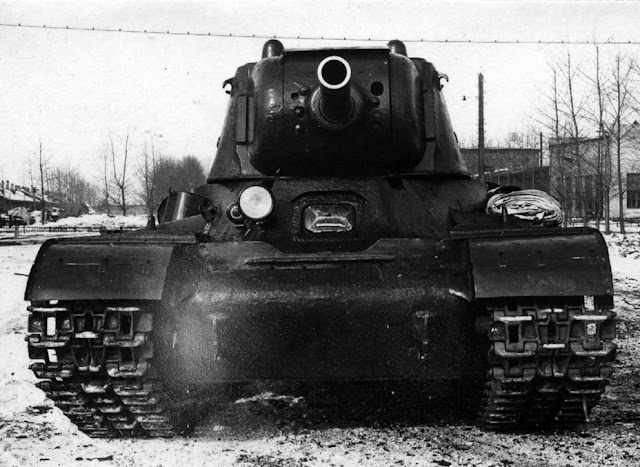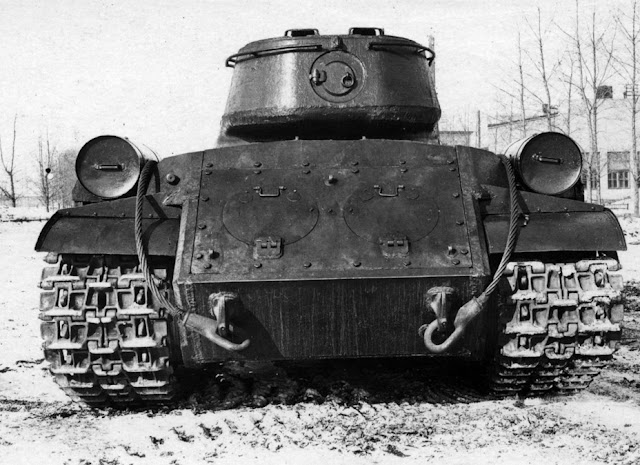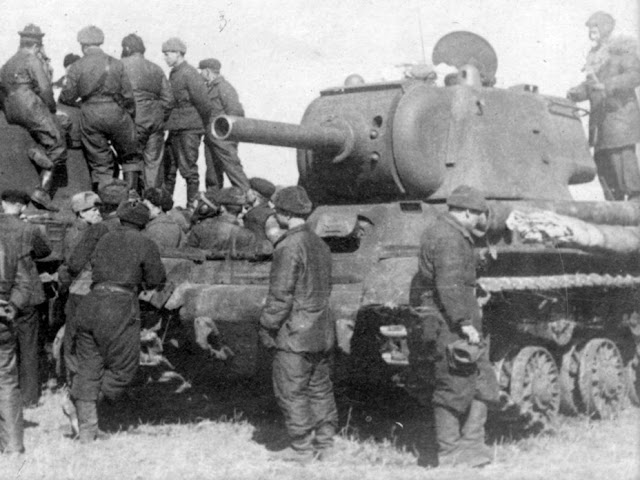The 122 mm U-11 gun designed in the fall-winter of 1941 was rather controversial. Its designers succeeded in their task of installing a gun with the ballistics of the M-30 in a minimally altered KV-1 turret. However, the howitzer had a low rate of fire, and its penetration characteristics were poor. As a result, the planed KV-9 batch remained on paper. Nevertheless, the GABTU did not give up on the idea of a howitzer tank. Despite opposition from the GAU, work on howitzer tanks continued in 1943.
Fire support
The failure with the KV-9 did not stop the GABTU. The gun was not an equal to the ZIS-5 due to its low rate of fire, smaller ammunition capacity, and, more importantly, lower penetration. However, the U-11 had one important advantage. The power of the 122 mm HE-fragmentation shell was much greater, which made the tank effective as a support tank. The KV-9 also used a very similar turret to the KV-1, which would make production simple.
Unfortunately, production of the KV-1 ceased in September of 1942, and the KV-1S took its place. It had a different turret design. Chelyabinsk tank designers also had no time for a howitzer tank, especially those rejected by the artillery branch. In addition to the KV-1S, the production of the T-34 was still a high priority. Finally, work on a completely new tank, the KV-13, was going very slowly.
Cutaway of the IS-2 howitzer tank. The turret design can be seen.
Interestingly enough, the KV-13 platform was the most interesting for the howitzer tank's developers. After trials of the first prototype were completed, work on an improved version began, which was significantly different from its predecessor. Documents on the improved KV-13, often called Object 233 (which is incorrect, since this index appeared only after trials were complete) or IS-1, were completed by early December 1942.
The project with blueprint index 234 appeared later. It is not known when the howitzer version of the IS-1 was created. This tank was left in the shadow of the main variant for a very long time. The name IS-2 first appears in documents in mid-February of 1942. Of course, work began some time before that. Officially, the index IS-2 first appears in GKO decree #2943 "On production of experimental IS tanks" issued on February 24th, 1943. The technical project was already complete by that point and work on the tank began.
There is a serious mistake that some historians make in connection with the IS-2. GBTU correspondence often mentions that the IS-2 used the turret from the KV-9. Researchers took this fact as truth, even coming up with the idea that the prototype KV-9's turret migrated to the IS-2. This assertion is baseless. There are photographs of the KV-9 when the IS-2 was already complete, and it still had its turret. The turret is also merely based on the one used in the KV-9. The design was different. It had no rear machinegun and a new vent in the roof. The total mass of the turret was 7465 kg, while the KV-9 turret weighed 9293 kg. Not surprisingly, the mass of the IS-2 was higher than the IS-1 by a ton, reaching 39.5 tons.
T-34 howitzer tank. March 1943.
The IS-2 could have seriously changed during its development. This is connected with two factors: the modernization of the SU-35 (SU-122) and the work of the design bureau of factory #9. A technical meeting where the design bureau presented the D-11 howitzer took place on the day GKO decree #2943 was signed. The D-11 was an improved U-11, featuring a simplified design and changes to several parts. This gun was mores suitable for installation in a tank, as it turned out to be more compact.
The size of the fighting compartment allowed the placement of three crewmen.
The compact dimensions of the D-11 reignited the GBTU's interest in an artillery tank on the T-34 chassis. The development was assigned to the factory #183 design bureau, who prepared a draft in March of 1943. The T-34 chassis was used without any changes. The biggest difference was an enlarged turret, somewhat reminiscent of the KV-2 one. A larger volume allowed it to house 30 rounds of ammunition and three crewmen. The mass of a howitzer-equipped T-34 would be 32 tons, just a little more than a regular T-34. The fate of this design was the same as of its predecessor. Theoretically, the introduction of a breech operator improved the rate of fire, but it was still less than that of the SU-35. As for the increased mobility of fire, it was not considered a critical parameter.
Installation of the D-12 tank howitzer into an IS-1 turret. April 1943.
The fact that a tank version of the D-11 was being developed at factory #9 was important news for the IS-2. This gun received the internal index D-12. The goal of the D-12 project was the unification of the SPG and tank variants, which was a reasonable objective from a manufacturing standpoint. Another important parameter was compactness. Factory #9's design bureau took the stock IS-1 turret into consideration when designing the D-12, which was ready by early April of 1943. Thanks to its compact design, the gun could fit into this turret. Since the turret was smaller than before, it was no longer possible to include most of the ammunition, but the idea of using the IS-1 turret was tempting.The NKV Technical Council approved of this decision.
An experimental prototype of the D-12 was built in early May, and went through trials on the 17th. The length of the recoil was reduced to 400 mm, which allowed for a more compact recoil guard. The gun passed robustness trials.
Heavy IS-2 tank in March of 1943. The air vent and antenna port in the turret are visible.
The IS-2 was not built with the D-12. GKO decree #2943 demanded the production of an experimental IS-2 by March 10th, 1943. It was not possible to have the D-12 completed by then, so the initial design with a KV-9-esque turret was chosen. For obvious reasons, the IS-2 was a lower priority design than the IS-1. Assembly was completed on March 12th, 1943, and factory trials began afterwards. On the 19th, changes to the design were made based on the results of the trials. The tank was finally delivered on March 28th. Accompanying documentation certified that it was equipped with U-11 gun with the serial number 6, a full set of spare parts, instruments, and accessories. The tank was fully tuned, lubricated, and fueled.
A view from the side also demonstrates some differences from the KV-9 turret.
Overall, the vehicle satisfied its tactical-technical requirements. Weighing showed that its mass was 37,900 kg, more than 1.5 tons less than expected. The difference compared to the IS-1 was also less than expected. The IS-2 was only 740 kg heavier. The crew consisted of four men, three of which sat in the turret.
The tank's chassis was identical to the IS-1, but the turret was different. As mentioned above, there were plenty of differences from the KV-9. It was about two tons lighter. The shape was also different, but there were many more noticeable changes. The roof had a vent and an antenna port, since the radio was moved to the turret. Lifting hooks and handrails were added on the sides. There were three lifting hooks, just like on the KV-1S tanks produced in the spring-summer of 1943. The designers also borrowed the side observation devices and the turret hatch from the KV-1S. The rear machinegun was replaced with a hatch for throwing out spent shell casings. In other words, there were plenty of changes. To keep the turret reasonably spacious, only 8 shells were carried. The overall ammunition capacity was 30 rounds, a quarter less than on the SU-122.
The IS-1 and IS-2 chassis were identical.
Mobility trials of the IS-2 began on March 28th and continued until April 15th. The tank travelled 773 km, of which 437 were on a highway, 276 on dirt roads, and 60 off-road. The average speed was 22-25 kph on a highway, 19.2 on dirt roads, and 18.3 off-road. This was approximately the same as the IS-1. The use of a bigger turret with a more powerful gun did not affect the tank's performance. As for reliability, the two tanks were equivalent. Most of the issues were caused by the quality of manufacturing rather than design flaws.
Another difference from the KV-9 was the addition of a hatch for throwing out spent shell casings instead of the machinegun.
The armament and turret were a whole different story. The loader's station was deemed cramped, and his work difficult. The gunner's station was also not free of omissions: the elevation flywheel clipped the recoil guard at high angles of elevation. It was also difficult to service the gun. The trials commission demanded that the fighting compartment be enlarged, including by widening the turret ring by 150 mm. This requirement was also applied to the IS-1. Management of the Chelyabinsk Kirov Factory refused, stating that the mass of the tank would increase by one ton. The commission also suggested that KV-1S observation devices be replaced with "English glass MK-IV devices", the ones used on the Churchill tank. The factory also disagreed with this suggestion, as the production of these devices had not yet started.
During trials, April 1943.
Trials of the IS-1 and IS-2 continued after state trials ended. By the end of May, the IS-2 had travelled for 1545 km. A more effective cooling system and a new design of the engine frame was being tested. The tank travelled for an additional 428 km on dirt roads in early June, demonstrating an average speed of 17 kph. The cooling system issues were the same as on the IS-1. They were caused by a poor placement of air intakes, which became clogged by dirt that the tank kicked up. The tank drove for 446 km in June and 2001 km in total.
It was already clear by then that the IS-2 will not go into production. The study of a captured Tiger tank showed that the prospective heavy tank needs to have an 85 mm gun. The turret ring would have to be widened to 1800 mm. The idea of the TsAKB to install the S-31 85 mm gun into the stock IS-1 turret was not approved by the GBTU. As a result, the IS-2 harshly dropped in priority in May. However, work on tank howitzers did not stop, merely moved to a new tank.
On the KV-1S chassis
A new step in howitzer tank development, as strange as it sounds, was taken after the study of a captured Tiger by Soviet specialists. GKO decree #3289 "On the improvement of artillery armament of tanks and SPGs" was issued on May 5th, 1943. It triggered the development of the D-5T 85 mm gun. The TsAKB began working on a similar project, which resulted in the S-18 and S-31 guns.
D-5T-122 howitzer in a KV-1S turret, June 1943.
As with the D-12, the new tank howitzer had its roots in an SPG gun design. In parallel with the D-5 and D-7, which were later renamed to D-5T-85 and D-5S-85, factory #9's design bureau began working on 122 mm guns. This was caused by the fact that the UZTM was still responsible for modernizing the SU-122. The result of this modernization was the D-6 gun, later renamed D-5S-122. With minimal changes, the 85 mm barrel could be swapped out for a 122 mm barrel with M-30 ballistics. This allowed for the SU-122-III to be rapidly designed.
The gun was much more compact than the U-11.
The KV-1S was the highest priority chassis for the new gun. It was clear that the IS-2 will not go into production, and experience with designing the D-12 indicated that, theoretically, a similar gun will fit into the KV-1 turret. The tank version of the howitzer was called D-8, and the name was later changed to D-5T-122. The technical project was ready by June 21st, 1943, and the explanatory memo by early July. It was stated that the D-5T-122 can be installed in the KV-1S and IS (Object 237) tanks.
An experimental prototype was built in July of 1943, but it was never installed in any of the aforementioned tanks. There were two reason for this plot twist. One was that the D-5S-122 behaved poorly on the SU-122-III. Issues with the recoil mechanism resulted in the SPG being removed from trials. The D-5T-122 showed similar issues. Factory trials were repeated on July 15th, and they concluded much more favourably.
The second reason was much more serious. After the fighting at the Battle of Kursk, where the Germans used new Panther tanks and Ferdinand tank destroyers, it was clear that a more powerful gun than the D-5T was needed. The GBTU was ready for this turn of events: the development of an SPG version of the A-19 122 mm corps gun began in April of 1943, and work on the D-25T tank gun began in May at factory #9. 122 mm tank howitzers were unnecessary in this situation. Guns with increased penetration, not better HE, were needed.
The SU-122 was replaced in production by the SU-85 in August of 1943, and production of the KV-85 began during that month. Nevertheless, one howitzer KV-1S was built after all.
Cutaway of the KV-1S with an S-41 gun. Late May 1943.
As mentioned above, not only factory #9 worked on tank howitzers, but also the TsAKB. There, P.F. Muravyev and E.V. Sinilshikov designed the S-31 85 mm gun in two variants. The gun lost to the D-5T, but further development led to the S-53. This gun was the main weapon of T-34-85 and T-44 tanks. It was TsAKB's greatest and at the same time last success in the field of tank guns. In parallel with the S-31, work on a tank howitzer, indexed S-41, began under the direct supervision of the bureau chief V.G. Grabin. The technical project was completed on May 27th, 1943.
The S-41 was even more compact than the D-5T-122.
As with the factory #9 design bureau, the howitzer was designed with the aim of using it on the KV-1S. It could also be installed in the IS-1. According to the description, the gun was meant for support of infantry and tank units for the destruction of fortifications and combat against enemy tanks. Thanks to its design it could easily be put into mass production. For example, it used the cradle of the 76 mm ZIS-5 gun and the breech of the 100 mm S-3 gun. A sliding breech increased the rate of fire. However, this was balanced out by a massive muzzle brake, which was not a great idea. It kicked up a cloud of dust during firing, which could reveal the tank's position.
According to calculations, the tank could carry 60 rounds of ammunition. The rate of fire was estimated at 5-6 RPM.
A massive muzzle brake was a downside of the S-41 design.
The note claimed that the turret would not have to be altered to fit the new gun, but the diagrams indicate that this is not so. The rear of the turret was changed, and the roof was raised. A turret turntable was also introduced. The need to alter the turret was not good for mass production of the weapon. Nevertheless, the project looked more promising than the D-5T-122. Aside from a larger ammunition capacity, this system had a higher rate of fire.
Unlike the D-5T-122, the S-41 was installed in a tank.
As with the D-5T-122, work moved out of the draft stage. A prototype S-41 was completed by early August and awaited installation in the S-18 SPG. This never happened, but the idea of installing the S-41 in a KV-1S tank that was testing the 85 mm S-31 was raised. The S-41 was eventually installed in a KV-1S, but a different one. However, that was the end. By the time the howitzer was installed in the KV-1S, the interest in this kind of vehicle waned.














